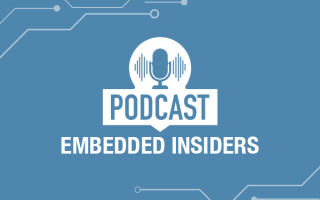Control issues: From protecting IP to monetizing it
November 01, 2012
As technology is increasingly driven by software, protecting IP has become critically important. Proper software licensing can not only defend against...
Embedded developers are evolving. As embedded systems transition to become combinations of solution-specific software running on off-the-shelf hardware, the value of Intellectual Property (IP) has increasingly transitioned to software. This evolution marks a significant change in how these hardware-turned-software vendors must operate to maximize profitability and continue delivering a positive customer experience.
To successfully monetize their IP, intelligent device manufacturers need to leverage the four aspects of a successful software monetization strategy: control, packaging, management, and tracking (see Figure 1). Each aspect directly affects profitability by either helping reduce costs or increase revenue.
The reality is that today’s embedded device manufacturers are facing a much more complex business environment that goes well beyond providing protection from tampering and reverse engineering of their products. Software monetization strategies for intelligent device manufacturers must take into account how these core elements are connected. Considerations such as profitability, user experience, and usage control directly affect each other and should be approached comprehensively. When software monetization strategies are implemented successfully, the intelligent device manufacturer can offer a more efficient experience for the user and a more profitable solution to the market. It all begins with controlling IP.
The key to controlling IP
Intelligent device manufacturers put hours and hours of time and know-how into developing unique software code that meets the needs of their customers and drives their businesses. Controlling that IP is the foundation of software monetization, as intelligent device manufacturers face problems with deliberate and unintentional misuse of their software, product and feature overuse, competitive IP theft, product reverse engineering, and code tampering – all problems that have plagued traditional software organizations for years. The key to controlling access and use of a device involves controlling who is granted access to the software running the device, when they’re granted access, and to what extent.
Access control
The software embedded within an intelligent device is typically a vendor’s most valuable asset. It not only holds all the development secrets hackers or competitors would love to gain access to, it also determines how the product functions. Stolen code can end up in the hands of competitors or be used to reproduce knockoff versions of a similar product.
While theft of trade secrets is one threat, for many intelligent device manufacturers, so is tampering. Both scenarios have great potential to damage overall market share and therefore decrease revenue potential. Tampering with the software embedded within a device can change how the device functions. This can provide users with access to features they have not paid for or, even worse, result in regulatory compliance problems. Without proper protection, intelligent device vendors are unknowingly leaving their code vulnerable to tampering.
By effectively controlling access to software source code, intelligent device vendors can protect revenue and safeguard the integrity of their brands and products by preventing product tampering, reverse engineering, and IP theft.
Usage control
Usage control is the next piece of the monetization puzzle. Vendors must be able to control the use of their software at the product and feature level to prevent overuse of their offerings – deliberate or unintentional – and ensure that they are being fairly compensated. As the intelligent device market continues to mature, it will be critical for vendors to minimize manufacturing costs while achieving greater flexibility in their product packaging. This is accomplished through feature-based licensing. By providing customers the flexibility to license software features of intelligent devices already on premise, and by controlling access to that software, vendors can create new revenue opportunities.
Leveraging control to improve customer experience
An effective software licensing strategy will not only give vendors the means to control how their software is accessed and by whom, it will also provide them with a tool to help develop sophisticated packaging and pricing strategies. In addition to preventing unauthorized access, these systems lay the groundwork to change how the intelligent device industry is able to do business. Control over software at the feature level enables vendors to consolidate hardware stock-keeping units and provide remote upgrade and support services, in addition to opening the door to a whole new world of marketing and sales tools.
In the past, if a vendor wanted a premium and a standard version of a piece of equipment, they would build two applications for installation on two different hardware platforms. If a standard customer wanted to upgrade to a premium device, they would have to return their old device and wait for the vendor to ship them a new one.
With feature-based licensing and entitlement management, device manufacturers can develop and maintain a feature-rich application installed on all devices. The functionality of the device is controlled through licensing. This enables software vendors to ship the same product with different functionality to different customers at varying price points and upgrade products remotely with lower support and fulfillment costs, thus delivering a better customer experience.
Tracking usage to evolve business strategies
The benefits of software licensing do not stop with control or packaging enhancements. Implementing a sophisticated licensing and entitlement management system also provides a means to to track product activation and usage right down to the feature level. Intelligent device vendors can use this information to drive decision-making around product packaging, roadmap investment, sales, and marketing strategies. Product management and engineering teams can discontinue feature combinations that are unpopular and create software packages containing the most valued features that customers want.
Marketing and sales teams can utilize customized reports to determine what, when, and how products are being used and leverage this data to plan, launch, and execute more effective sales and marketing activities (see Figure 2). End-user registration data can also help vendors who sell via multiple channels to identify and gain direct access to every individual who uses one of their products.
Licensing best practices: case studies
Because most intelligent devices, software and licensing systems, end users, and ecosystems are all unique, examples of licensing best practices can help illustrate some key elements of an effective software monetization strategy.
Example 1: Protecting software code from theft and resale
The first example is a software publisher who provides a compression algorithm that is nearly lossless. It is imperative that the algorithm not be deciphered because it is critical IP and unique in this company’s industry. The software publisher leveraged the code-wrapping feature of a software licensing solution to protect their code from reverse engineering and therefore protect their competitive IP from getting into the hands of pirates or the competition.
Example 2: Leveraging feature-based software licensing
Another example is one of the largest networking companies in the world that decided to monetize the software that ships on their appliances. The company used a sophisticated software licensing and entitlement management implementation to protect their code and created smart, feature-based licensing packages for their enterprise customers to maximize the return on their IP.
Example 3: Protecting software from tampering
The last example is a company in the manufacturing industry that develops machines that create end-to-end packaging of consumer food products such as milk and orange juice. The software that runs these machines is programmed to comply with dozens of public health and safety regulations. The company’s IP protection concerns centered around controlling access to the software running the machines and the ability to tamper with key parameters that control processes such as pasteurization. This company used a software monetization solution to protect the software from being accessed and control who can change the parameters that control the machines.
Confidence in greater protection
Shifting from an equipment manufacturer business model to that of a software company does not happen overnight and typically occurs in phases. Intelligent device manufacturers who embrace the transition and use software monetization tactics to overcome the challenges they face will be able to vigorously pursue greater market share and reduce manufacturing and inventory costs with the confidence that they are protected against competitive threats to their IP. They will also be able to more cost-effectively expand their product lines and bring innovative devices to market. In short, those vendors making the transition to a software business model will be more nimble and better positioned for the future.
SafeNet [email protected] www.safenet-inc.com/software-monetization-solutions
Follow: TwitterLicensing TwitterNerlinger Blog Facebook Google+ Linkedin YouTube







